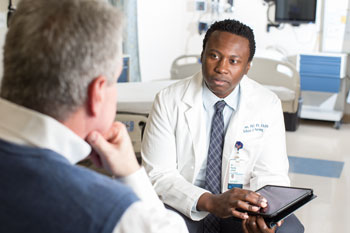You've been diagnosed with prostate cancer. Now what?

 A prostate cancer diagnosis brings a bevy of questions: Is incontinence inevitable? How long will it be until the catheter is removed? Will out-of-pocket costs crush me? Will I ever have sex again?
A prostate cancer diagnosis brings a bevy of questions: Is incontinence inevitable? How long will it be until the catheter is removed? Will out-of-pocket costs crush me? Will I ever have sex again?
But for some patients, even knowing what questions to ask is difficult. What they lack, says associate professor of nursing Randy Jones (BSN '00, MSN '02, PhD '05), is a measured way to personally assess their own circumstances—a method to consider their priorities and make treatment decisions with their eyes wide open.
Enter the decision aid. As healthcare systems increasingly put patients in the driver's seat - what hospitals often call "patient-centered care" - tools like the one Jones is creating with a $2.2 million grant from the National Institutes of Health will help patients and their loved ones better weigh risks, benefits, and potential side effects so they aren't plagued by regret.
"Often, we hear patients say, 'I wish I could've done things differently,'" explains Jones, "or, 'I wouldn't have stayed on chemo if I'd known about these side effects.' Others say they felt pressured by their healthcare provider to pursue aggressive treatments, or didn't want to let others down by giving into cancer, and pushed on for a little longer as a result," ultimately regretting that choice.
Jones's four-year, three-site study will include 158 interviews with subjects diagnosed with advanced prostate cancer at the University of Virginia's Emily Couric Clinical Cancer Center, Virginia Commonwealth University's Massey Cancer Center, and the Sidney Kimmel Comprehensive Cancer Center at Johns Hopkins University. He will then test the effects of a novel decision aid delivered by tablet computer and administered by nurses. The study will include 63 African-American men, 94 Caucasian men, and 1 Asian man. Half of the participants will receive the decision aid, while the other half will receive established protocols of care (informational brochures and oral counsel from clinicians). Subjects will be queried about stress, pain and risk tolerance, their hopes for treatment, and preferences related to quality of life versus longevity.
Jones's chief aims are two: determine whether patients who receive the decision aid experience less decisional conflict, uncertainty, and regret—thereby achieving a greater quality of life; and see whether patients' decision-making partners report less treatment regret and a higher quality of life.
He also hopes to better understand whether the decision aid has a greater impact on certain racial groups, like African-Americans, who, Jones says, may be more likely than patients of other races to make decisions in conjunction with a family member. That's an important question, because African-American men are more than twice as likely as whites and Hispanics to be diagnosed with the disease, but are less likely to be involved in active decision making regarding treatment.
About two-thirds of all prostate cancers are diagnosed in men age 65 and older. The American Cancer Society estimates that 161,310 new cases of prostate cancer will be diagnosed in 2017, and nearly 27,000 men will die from it. While one in 39 men diagnosed with prostate cancer will die of it, survivability is frequent; 2.9 million men diagnosed with prostate cancer are still alive.
###
